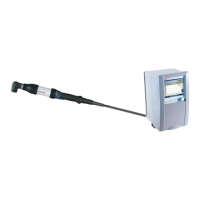150/641 Bosch Rexroth AG | Tightening Technology 3 608 878 300
System 350 | 3 608 878 300/2019-03
In contrast to theNOK signal, theNOKByps signal only indicates that a tightening application is NOK if a
NOK-tightening is present in an active tightening channel. However, bypassed tightening channels are
evaluated with OK.
OK OK: Results OK
Output signal used for:
• Tightening channel (OK)
• Communication unit in single-channel operation (CH x.y OK)
• Communication unit in application operation (FO x OK)
This signal indicates that the tightening process or the KE tightening application was evaluated with OK.
It is set to "low" when the subsequent tightening program or tightening application is started or the results
are deleted via the ResRs signal.
OKByps OK Bypass: Results OK
Output signal used for:
• Communication unit in application operation (FO x OKByps)
This signal indicates that the KE tightening application was evaluated with OK. In contrast to theOK
signal, this is the case even if at least one tightening channel has been deselected in the application. It is
set to "low" when the subsequent tightening application is started or the results are deleted via the ResRs
signal.
RC0-4 Rework Code Bit 0-4: Rework code bit 0-4
Output signal used for:
• Tightening channel (RC0-4)
• Communication unit in single-channel operation (CH x.y RC0-4)
These five output signals are used to output the binary encoded rework code. A rework code can be used
to inform the user on the steps required for reworking a tightening operation that has been evaluated as
NOK (e.g. as a message on the TFT display or as a number on the LC display of the LTU350/1).
These signals are set at the end of a tightening operation; they change to “low” when tightening is started
and when the Reset result signal is set.
Rdy Ready: Tightening cell/tightening application no. x ready for operation
Output signal used for:
• Tightening channel (Rdy)
• Communication unit in single-channel operation (CH x.y Rdy)
• Communication unit in application operation (FO x Rdy, KE Rdy, FC Rdy)
A tightening channel cannot be started before the Rdy signal reports "ready" (Rdy signal = "high").
A tightening application cannot be started before the FO x Rdy signal reports "ready" (FO x Rdy
signal = "high").
Signal description for tightening applications:
FO x Rdy indicates that the tightening applications selected via the FO x Seq 0-5 signals are ready
to start. This means that the tightening application selected via FO x Seq0-5 cannot be started
before FO x Rdy has signaled "high". The following conditions must first be met:
• Enabled by PLC: FC En =„High“
• KE is ready-to-operate: KE Rdy =„High“
• For all tightening channels involved in the application: Rdy = "high" (ready-to-operate) and InCy =
"low" (start active=inactive)
A tightening channel involved in the application must not be released for individual channel operation via
the "Ch x.y SEn" signal.
The FO x Rdy signal can be used to prevent, e.g. two tightening applications which access the same
tightening channels from being started simultaneously.

